At What Temperature Would An Animal Freeze To Death Overnight
The man who refused to freeze to death
(Prototype credit:
Getty Images
)
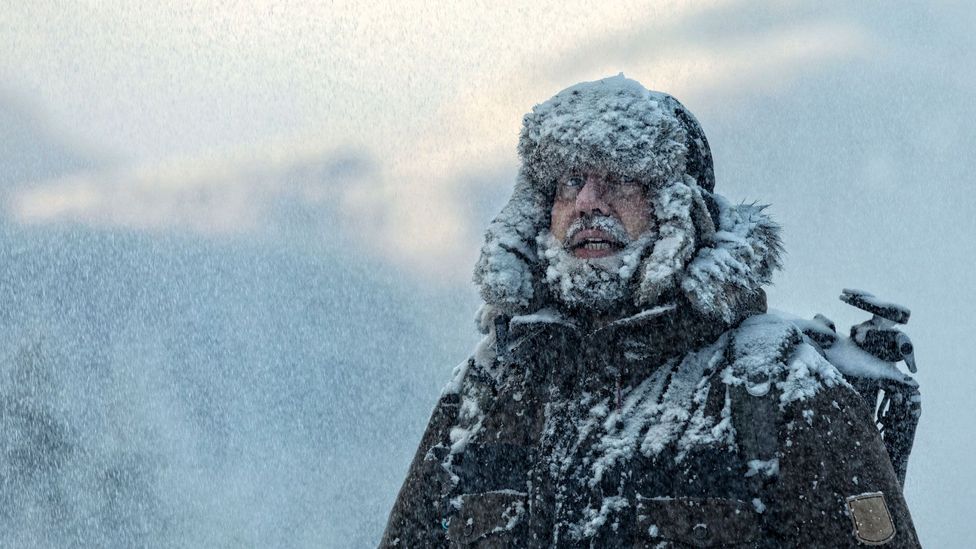
Lost, wet and alone in a freezing, snowfall covered landscape, an Icelandic fisherman'due south story of survival against the odds reveals the homo body'southward remarkable ability to accommodate to the cold.
T
To mark the end of a turbulent year, we are bringing back some of our favourite stories for BBC Futurity's "All-time of 2020" collection.Discover more of our picks here.
Heimaey is the largest of the Westman Islands, an archipelago south of Iceland mostly inhabited by puffins. On Stórhöfði peninsula, at the southernmost signal of Heimaey is an outcrop that juts into the Atlantic Ocean. The local atmospheric condition station here claims to exist one of the windiest places in Europe.
It was here, in the early hours of March 12 1984, that 23-year-sometime Guðlaugur Friðþórsson stumbled towards salvation. His bare feet were bleeding from deep cuts caused by the volcanic stone hidden below the snow, his dress soaked in seawater and frozen to his body. He should have already died several times over, but something deep inside Friðþórsson propelled him forrad.
The dark was articulate and cold. The air temperature was -2C (28F) just with strong winds it would have felt much colder. Despite the freezing temperatures, he paused at a bathtub filled with water left out for sheep for a brief respite. Punching through the centimetre-thick ice he began to gulp downward water from the trough.
You might also like:
- The tragic tale of Mt Everest'south most famous dead body
- What it's like to survive a shipwreck
- Tin you lot survive if yous run out of air?
It is perhaps strange that a drink of ice cold water was a primary concern at a fourth dimension similar that. Merely dehydration is a surprising business in common cold environments as the air in sub-naught temperatures is essentially freeze-dried. With no moisture in the air, when he breathed out, he was losing vital fluid from his lungs. It is why you can see your breath hanging in the air on a common cold nighttime.
But the cold also appears to edgeless our awareness of thirst, meaning many people do not take in plenty water. If you are working hard to stay warm, and breathing heavily as a result, it can quickly lead to aridity.
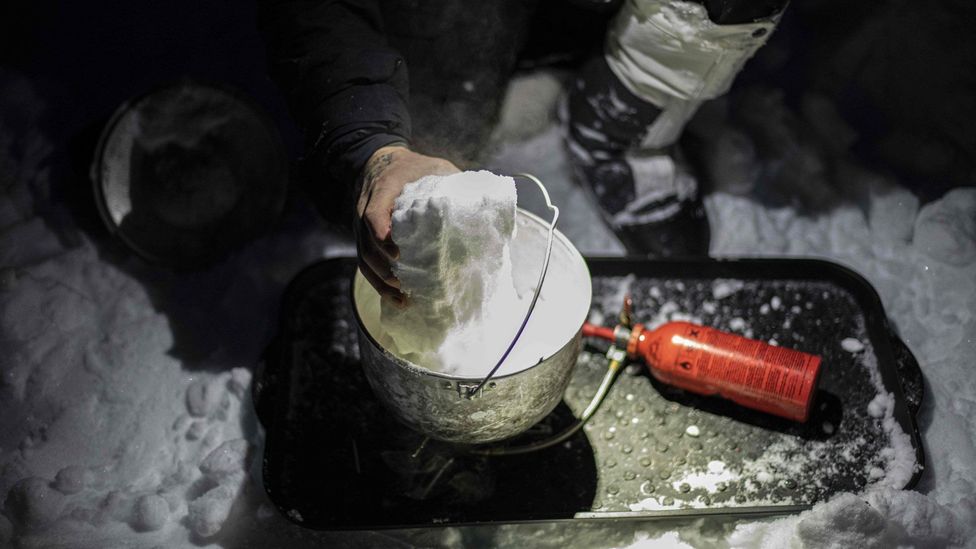
A French soldier melts snow as part of a grooming practise (Credit: Getty Images)
"You tend to see a lot of problems with cold compounded by dehydration," says Mike Tipton, professor of physiology at the University of Portsmouth.
Having found fresh water, nevertheless, dehydration was not Friðþórsson'due south biggest problem. His wet dress were quickly making his status worse, putting him at take a chance of hypothermia, which occurs when the core body temperature drops below 35C (95F). While exercising, he could proceed his core temperature high. Just having stopped to take a drink, his source of heat – generated by the motion of his muscles – had been cutting off. While he still had calories to burn, he had to keep moving.
"A man in the cold is not necessarily a cold man," says Tipton. "If yous go along moving and you are reasonably insulated you will produce enough heat to stay warm. At maximum practice, information technology is similar you are running a 2kW fire. When you exercise reasonably hard you can exercise that in shorts and t-shirt in the common cold. Even when you have to shiver you lot are essentially engaged in light exercise."
People at high altitude might find exercising more difficult. Tipton says that climbers on Everest might only exist able to manage one stride every 10 seconds. Oestrus production at this rate of exercise is minimal, so staying warm is very difficult.
Records of climbers who have succumbed to the common cold at altitude are plentiful, oftentimes considering radio advice can exist maintained until they autumn unconcious. In one harrowing account of several climbers stranded on Peak Lenin in a blizzard in 1974, their final moments were relayed to base camp.
The group, led by Elvira Shatayeva, were attempting to go the starting time all-women group to scale the mountain, in modern-day Tajikistan. Every bit they grew colder, their thoughts became increasingly disoriented and they spoke of how weak they were condign: "Another has died," Shatayeva is recorded as proverb in 1 of her concluding messages, "... I do not have the strength to hold down the transmitter button."
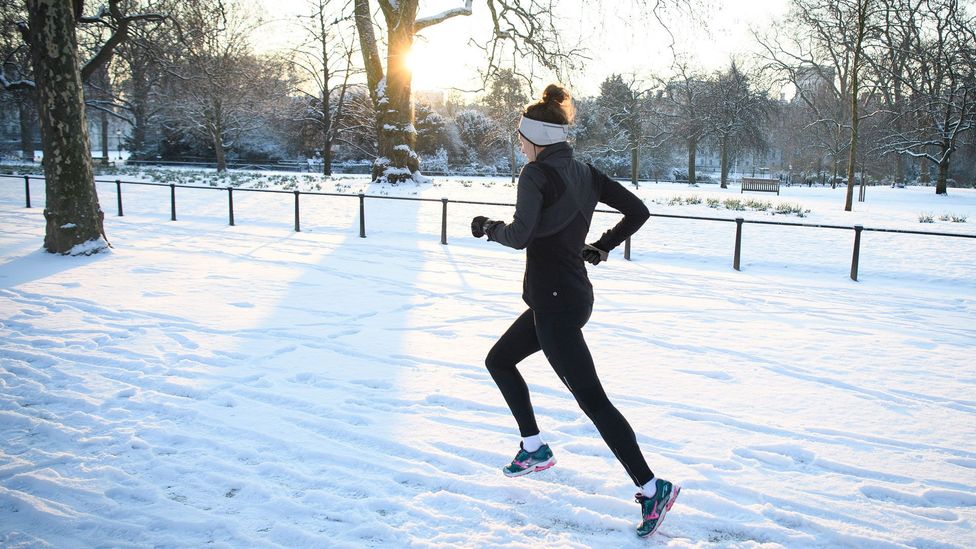
At maximum exercise, heavy layers of protective wearable are not required to stay warm (Credit: Getty Images)
While there is bear witness that extreme rut affects people'due south cognitive abilities, it is less clear what, if anything, farthermost cold does to the mind. In one paper, people dunked in 2-3C h2o for 3 minutes (plenty time for someone to develop and go over the cold shock response) saw a decline in their brusque-term retention but improved in other areas, like their alertness. Another newspaper plant that people brought very close to the signal of hypothermia (their core body temperature was lowered to 35.5C) suffered no reject in cerebral function at all.
It would appear that our brains are much better at coping in the cold than dealing with being as well hot. This is considering our bodies' survival strategies centre around keeping our vital organs running at the expense of less essential trunk parts. The most essential of all, of class, is our brain. Past the time that Shatayeva and her boyfriend climbers were experiencing cognitive issues, they were probably already experiencing other organ failures elsewhere in their bodies.
Our bodies are very good at reducing blood catamenia, through a process called vasoconstriction, to our hands and feet to preserve our cadre torso temperature. But in doing so, we sacrifice estrus in those extremities. Human being tissue freezes at around -0.5C. As fluid in our tissues begins to freeze, our prison cell walls break leading to necrosis, or cell decease. We call this frostbite.
However, being close to the point of death from hypothermia can apparently exercise strange things to the mind. In some rare cases, people suffering from farthermost cold appear to experience hot in the moments before they die. Some bodies of hypothermia victims are found partially dressed, or even fully undressed, in a phenomenon called "paradoxical undressing".
It might be that at the very terminal moments before death, the mechanism that holds blood beneath our fatty layer fails, causing it to rush to the surface of the skin and giving the awareness of beingness flushed with warmth. In reality, the victims suddenly lose huge amounts of rut. Getting undressed simply speeds up how chop-chop they die.
Nigh of these cases (67% of men and 78% of women) involve people who have consumed booze, which is known to inhibit our thermoregulatory response.
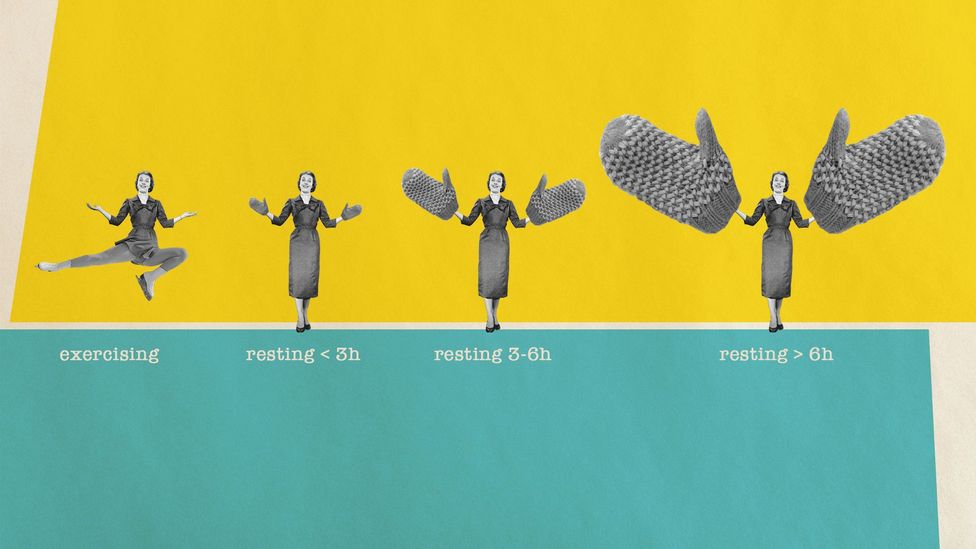
Even at -32C (-20F), people who are strenuously exercising do non need gloves. The all-time gloves will only piece of work for upwardly to 3 hours at rest (Credit: Javier Hirschfeld/ Getty Images)
Like with paradoxical undressing, information technology would appear that in the very last moments before death the victims are overcome with defoliation. Well-nigh a quarter of these people also undressed themselves before hiding.
Those few people who accept been found frozen to expiry and paradoxically undressed frequently savage victim while walking home at night in improper habiliment, sometimes drunk. For anyone in a survival situation, at that place are iii lines of defence that protect confronting the cold.
"Clothing or equipment is the first line of defence, shelter is second and third is burn," says Jessie Krebs, a sometime US Air Force Survival, Evasion, Resistance and Escape (Sere) Training Instructor. "People will skip right to fire after vesture has been compromised, which is a fault. If they are not successful they die trying to start a burn."
This was the situation that faced 30-year-quondam charlatan Tyson Steele at the cease of 2019. Thick snow blanketed the remote, forested corner of the Susitna Valley where Steele's cabin stood. He slept wrapped up warm against the freezing temperatures exterior while the remains of his fire glowed in the wood-burning stove.
A tiny ember drifted up the chimney and settled on the tarpaulin, that formed much of the roof of his hut, where it quietly smoldered. At the odour of the burn, Steele dashed outside to find flames bursting from the plastic roofting. Within a few minutes the whole hut was ablaze.
This was the get-go of what would become a three-week ordeal for Steele, stranded 20 miles from the nearest boondocks in sub-zero weather condition in the Alaskan wilderness. Over the following 20 days or so, he faced a battle to stay warm and alive in the hope of rescue.
Unable to motility far in the deep snow, his plan was to stay put, which nether the circumstances was not a bad ane. After clothing, shelter is next in the hierarchy of defence against the common cold. He salvaged some canned food and blankets, congenital a shelter out of debris from his hut, and lit a fire.
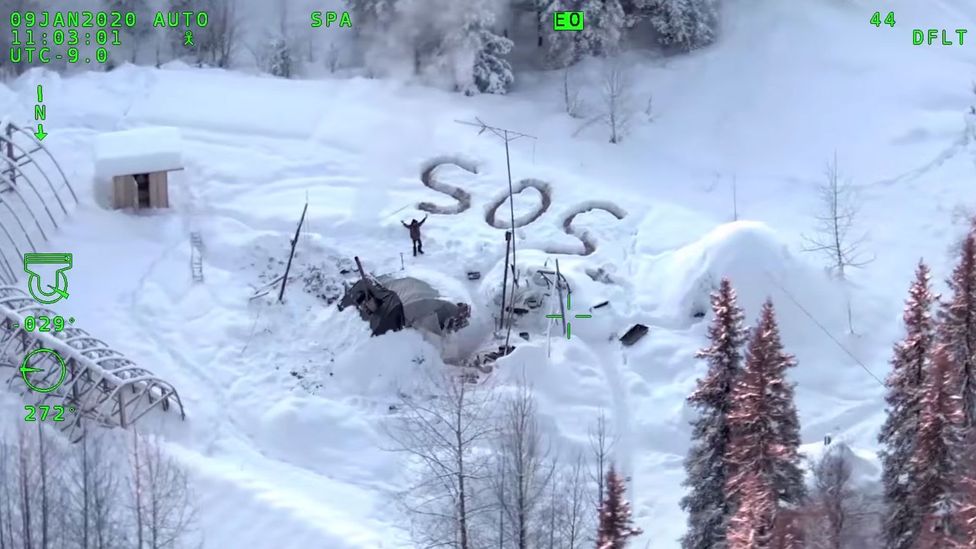
Tyson Steele waves to the circling State Trooper helicopter surrounded by the droppings of his hut (Credit: Alaska State Troopers)
At this indicate, Steele'south outlook was pretty positive; his three lines of defense were in gild. He stomped out an SOS message side by side to his hut and waited for help.
"If you know help is coming, you are amend off digging a snow pigsty and staying put," says Tipton. "People in Canada say all you are doing is staying put until you dice because no one will find yous. But if you are fit and take food, if you sent a mayday and you know they will exist coming yous are meliorate off building a snow hole and not heading into a blizzard."
While staying at the motel he had kept in touch regularly with his family unit, and posted on social media. Just when those letters went quiet, his family grew concerned. Fortunately for Steele, his silence was noticed and ultimately saved him, non his SOS.
"The SOS indicate is what most people know, but the downside is it is very curvy," says Krebs. "Nearly of nature is curvy – it is rounded hills and lakes and streams, so curvy blends in."
In the armed forces Krebs was taught to apply the alphabetic character "Five" to request general help or an "Ten" specifically for medical aid. The long straight lines stand out on a hillside. It likewise takes less time to create two direct lines thirty anxiety long compared to two loopy Ss and ane O, each ten feet high.
The footage of his rescue, recorded from a helicopter circling above him, shows Steele waving with two arms aloft to his saviours while standing in front of his SOS. While two artillery in the air is widely recognised to be a request to be picked up (only i arm could exist misinterpreted as a greeting), Krebs says the most constructive mode to communicate distress is to lie down on the basis. Provided you are certain that the pilot has seen you, lying downwards quickly communicates that you are hurt or sick and therefore need aid urgently.
Other forms of basis to air communication include using signal mirrors. A mirror from a car sun visor tin be repurposed for this. Property the mirror over 1 eye and aiming by fixing the target between your fingers held out in front end of you in a "V", a signal mirror can draw attention up to 50 miles (80km) away in clear skies. Other alternatives are smoke signals – the water in branches and leaves from fresh vegetation creates white smoke when burned, which is useful in dark forests. Burning rubber or car tyres can produce black smoke that will stand out against snowfall. But Krebs warns this is only really useful if at that place is an aircraft in the area.
Steele later admitted he had no formal survival training, but had picked up some cognition from YouTube videos. A few matches, a candle and some birch bawl helped him to start a fire, which he could use to keep dry out.
Existence able to maintain and repair clothing is essential to increasing your chances of survival says Krebs. In a worst case scenario, wet clothes can be wrung out and pushed through powdery snow to absorb some water. Merely in Friðþórsson's instance, he was already style beyond this betoken.
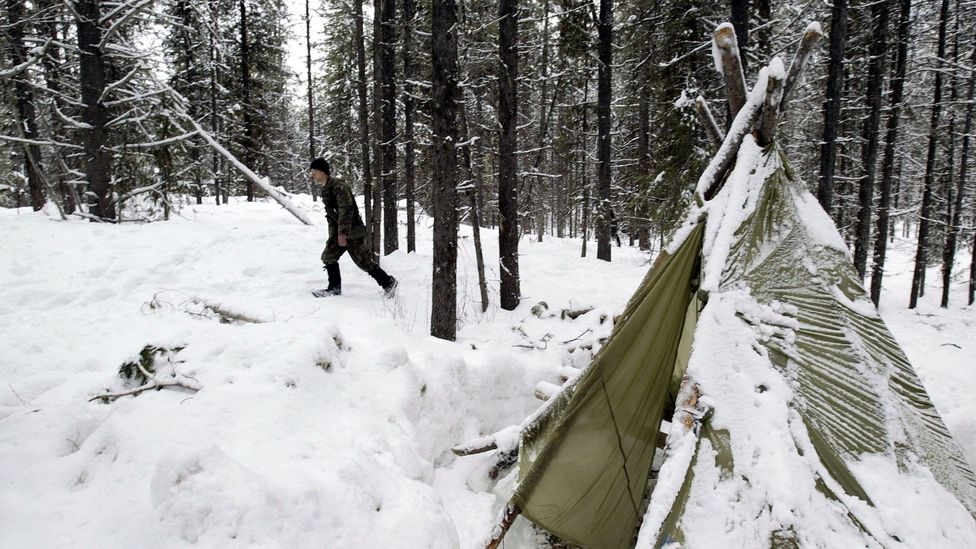
A soldier takes part in Sere training in Colville National Forest, Washington, on a freezing January morning time (Credit: Getty Images)
Friðþórsson had fallen into the bounding main just e of Stórhöfði peninsula when his the minor fishing vessel, Hellisey VE 503, ran into problem. At 10pm, her trawl net caught on the ocean flooring capsizing the boat then rapidly the crew had no fourth dimension to send a distress signal.
Her five fishermen were thrown overboard. Iii of them managed to scramble onto the keel of the upturned fishing gunkhole, 2 never resurfaced.
The survivors found themselves separated from shore by three miles (5km) of v-6C (41-43F) sea. An average person will survive in water colder than 6C for nearly 75 minutes. Accounts of people surviving for longer are anecdotal and few. In laboratories, test subjects begin to endure adverse effects inside 20 or 30 minutes before they are pulled out. To swim three miles in these seas would take hours.
Seawater cannot get really, really cold like air. Seawater freezes at about -1.9C (28.6F), but effectually Iceland in March the sea is merely in a higher place freezing. Information technology is theoretically possible to get frostbite in cold water, and then, but very unlikely.
On the keel of the upturbed boat, however, the sub-feezing air temperature was taking its toll. The fishermen'southward moisture shirts, sweaters and jeans were apace exacerbating their coldness. Staying put was non an option.
"When you come up out of the h2o y'all get evaporative cooling," says Tipton. "This is a really potent way of losing heat from the body." Ordinarily you would desire to strip off and put dry clothing on, just in the absence of that, climbing into a large plastic bag will reduce evaporative cooling and convective cooling.
"If you go someone moisture at 4C and they have got a litre of water in their clothing; if all of that h2o evaporates they are going to have a fall in body temperature of 10C," says Tipton. "If you put them through the aforementioned scenario and and then put them in a plastic bag they tin utilize their body to heat upward that water. It is contained in the bag so it cannot evaporate away. Those people lost one-half a degree, and so they were 20 times better off."
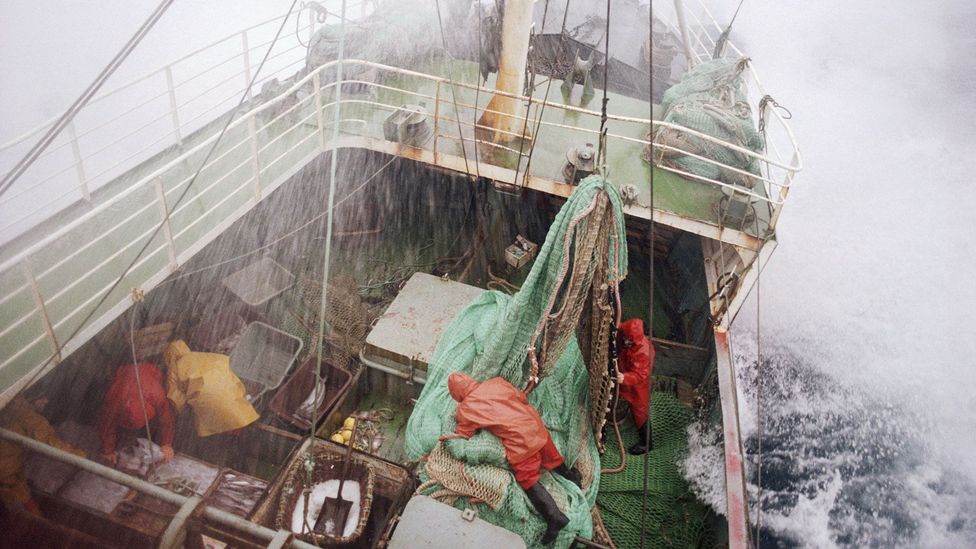
The fishermen were separated from land past three miles of frigid sea (Credit: Getty Images)
Tipton says ane of the big successes his team at the Academy of Portsmouth have had was to encourage the Imperial Canadian Mounted Police to ditch their expensive foil space blankets in favour of cheap, tough, plastic survival bags. Space blankets, the kind that are wrapped around marathon runners at the end of races, are good at protecting confronting radiative heat loss, simply less good when information technology comes to evaporative heat loss, because they do not trap fluid. In a survival situation, a plastic bag would be far more than useful.
Without a plastic survival bag, and at present in the cold air with the seawater evaporating off him, Friðþórsson's risk of freezing common cold injuries was very high.
Subsequently a brusque while deliberating, the iii men decide to adventure the swim. Within 10 minutes, the two others had succumbed to the cold. In all, it took Friðþórsson six hours to swim to state. How was he able to survive for so much longer than his compatriots?
For the fishermen, the outset few minutes after hitting the h2o were critical. Cold water takes heat away from the body quicker than air at the aforementioned temperature. Those that succumbed rapidly were probably unable to control the common cold stupor response. Gasping and panicking, they inhaled water. Friðþórsson, past contrast, managed to command his breathing.
He afterwards described remaining clear-headed throughout his swim. He even chose to go back in the sea to swim further along the shoreline after the cliffs at his first landing spot proved too difficult to climb. The presence of mind to practice this probably saved his life.
Finally, Friðþórsson reached a village, and effectually 7am on Mon morning he knocked on someone'southward door. He was later on discharged from hospital having been treated for his cuts and dehydration. There was no sign that he had suffered from hypothermia at all.
Friðþórsson, now 58, is a big human. He stands 6'3" (193cm) and weighed 19.6 stone (125kg) in his twenties. A generous layer of fatty well-nigh two and a half centimetres thick wraps his abdomen. His trunk fat kept him insulated, merely it was too a vital source of energy.
Yet, his ability to stay warm was exceptional. Researchers who conducted tests on Friðþórsson afterwards his ordeal concluded that he must have been able to maintain nigh normal torso temperature for the entirety of his swim.
Different other extreme survivors, Friðþórsson has non fabricated his story into a money-spinner. A 2012 independent Icelandic film is the sum full of the mainstream coverage. The clothes that he wore, now on display in the Eldheimar Museum on Heimaey in a small showroom to the island's fishing history, are a modest recognition for his remarkable story.
--
Join ane million Future fans past liking united states of america on Facebook , or follow us on Twitter or Instagram .
If you liked this story, sign up for the weekly bbc.com features newsletter , chosen "The Essential Listing". A handpicked pick of stories from BBC Future, Culture, Worklife, and Travel, delivered to your inbox every Friday.
Source: https://www.bbc.com/future/article/20200226-how-to-survive-in-the-extreme-cold
Posted by: rainesoves1951.blogspot.com

0 Response to "At What Temperature Would An Animal Freeze To Death Overnight"
Post a Comment